The Centre for Microscopy and Microanalysis is pleased to announce the installation of the Bruker Ultraflextreme MALDI-TOF/TOF mass spectrometer, which has been recently relocated from Queensland Institute of Medical Research Berghofer (QIMR Berghofer). This instrument represents an increased level of co-operation and collaboration between UQ-CMM and QIMR Berghofer to deliver access to high cost and specialised research infrastructure to researchers at both institutions. The Ultraflextreme replaces the last of our Bruker Ultraflex III MALDI TOF/TOF instruments, which are no longer supported, and it offers increased performance in terms of acquisition speed with the laser repetition rate increasing from 200 Hz to 2000 Hz, increase in mass resolution in reflector mode from approximately 20000 to potentially 40000. Overall, the instrument allows the same experiments to be performed but faster and with better quality mass spectra. Data acquired from the Ultraflextreme can be analysed using a full suite of analysis software for polymer samples (MS repeat and Polytools), and either Flex Imaging or SCILS LAB for Mass Spectrometry Imaging experiments.
The Bruker Daltonics Ultraflextreme is a MALDI-TOF/TOF mass spectrometer, and uses smartbeam™ II laser technology, with a repetition rate tunable from 1 to 2000 Hz, and an adjustable focus size from 10 μm to 80 μm. The instrument can be operated in linear mode with mass range of 500k, at very high sensitivity to measure large molecules. If higher mass resolution (up to 40,000) and mass accuracy is required, the instrument can be operated in reflectron mode. MS/MS experiments can be performed in LIFT mode, or using ISD processes. Typical experiments that can be carried out include rapid MALDI spot analysis, LC-MALDI analyses, and Tissue Imaging. In addition to the hardware we have several software packages for data analyses including, Flex Imaging and SCILs lab for Tissue Imaging data, WARP-LC, Biotools and Mascot for LC-MALDI proteomics data, and ClinProt Tools for clustering and modelling of large MALDI spot data sets. We also have recently added PEAKS Studio to allow for denovo sequencing and peptides searches orthogonal to Mascot.
The following spectrum is typical for MALDI spot analysis of proteins in linear positive mode. Additionally antibodies can analysed using this mode.
The next example show analysis of 2K PEG using DCTB as a matrix in reflector positive mode.
Below are Mass Spectrometry Imaging results typical for phosphatidylcholines present in rat brain. Carried out at 50 µm pixel size with DHB matrix using the Ultraflextreme.
The Ultraflextreme is now available for use at the Centre for Microscopy and Microanalysis, in the same openly accessible manner as other existing infrastructure within CMM. Once trained, users can book and use the instrument at the Hawken Lab (Bld 50).
Location: Hawken Building #50 (Room L106)
Contact: Brett Hamilton: b.hamilton@uq.edu.au







